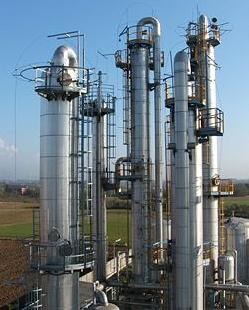User:Milton Beychok/Sandbox: Difference between revisions
imported>Milton Beychok No edit summary |
imported>Milton Beychok No edit summary |
||
| Line 1: | Line 1: | ||
[[Image:Industrial Distillation Columns.jpg|right|thumb|250px|{{#ifexist:Template:Industrial Distillation Columns.jpg/credit|{{Industrial Distillation Columns.jpg/credit}}<br/>|}}Industrial continuous distillation columns.]] | [[Image:Industrial Distillation Columns.jpg|right|thumb|250px|{{#ifexist:Template:Industrial Distillation Columns.jpg/credit|{{Industrial Distillation Columns.jpg/credit}}<br/>|}}Industrial continuous distillation columns.]] | ||
'''Continuous distillation''' is an ongoing process in which a liquid mixture of two or more miscible components is continuously fed into the process and continuously separated into two or more products by preferentially boiling the more volatile components out of the mixture | '''Continuous distillation''' is an ongoing process in which a liquid mixture of two or more miscible components is continuously fed into the process and continuously separated into two or more products by preferentially boiling the more volatile components out of the mixture. <ref name=Kister>{{cite book|author=Kister, Henry Z.|title=[[Distillation Design]]|edition=1st Edition |publisher=McGraw-Hill|year=1992|id=ISBN 0-07-034909-6}}</ref><ref>{{cite book|author=King, C.J.|2nd Edition|title=Separation Processes|publisher=McGraw Hill|year=1980|id=0-07-034612-7}}</ref><ref name=Perry>{{cite book|author=Perry, Robert H. and Green, Don W.|title=[[Perry's Chemical Engineers' Handbook]]|edition=8th Edition| publisher=McGraw-Hill|year=2007|id=ISBN 0-07-142294-3}}</ref><ref>{{cite book| author=McCabe, W., Smith, J. and Harriott, P.|edition=7th Edition|title=[[Unit Operations of Chemical Engineering]]|publisher=McGraw Hill|location=|year=2004|id=ISBN 0-07-284823-5}}</ref> | ||
Large-scale, continuous distillation is used widely in the chemical process industries where large quantities of liquids have to be distilled, as in [[Petroleum refining processes|petroleum refining]], [[natural gas processing]], [[petrochemical]] production, [[coal tar]] processing and the liquefaction of [[Gas|gases]] such as [[hydrogen]], [[oxygen]], [[nitrogen]], and [[helium]]). | |||
Distillation is one of the [[unit operations]] of [[chemical engineering]]. If the feed contains more than two components, it is referred to as ''multi-component distillation'' | Industrial distillation is typically performed in large, vertical cylindrical columns (see adjacent photograph) known as "distillation towers" or "distillation columns" with diameters ranging from about 65 centimeters to 11 meters and heights ranging from about 6 meters to 60 meters or more. | ||
Distillation is one of the important [[unit operations]] of [[chemical engineering]]. If the feed contains more than two components, it is referred to as ''multi-component distillation'' and, if it contains only two components, it is referred to as ''binary distillation''. | |||
==Principle== | |||
When a liquid mixture is heated, the evolved vapor will have a higher concentration of the more [[Relative volatility|volatile]] (i.e., lower [[boiling point]]) components than the liquid from which it evolved. Conversely, if a vapor mixture is cooled, the less volatile components will tend to condense in a higher proportion than the more volatile components. | |||
Revision as of 15:00, 19 July 2008
Continuous distillation is an ongoing process in which a liquid mixture of two or more miscible components is continuously fed into the process and continuously separated into two or more products by preferentially boiling the more volatile components out of the mixture. [1][2][3][4]
Large-scale, continuous distillation is used widely in the chemical process industries where large quantities of liquids have to be distilled, as in petroleum refining, natural gas processing, petrochemical production, coal tar processing and the liquefaction of gases such as hydrogen, oxygen, nitrogen, and helium).
Industrial distillation is typically performed in large, vertical cylindrical columns (see adjacent photograph) known as "distillation towers" or "distillation columns" with diameters ranging from about 65 centimeters to 11 meters and heights ranging from about 6 meters to 60 meters or more.
Distillation is one of the important unit operations of chemical engineering. If the feed contains more than two components, it is referred to as multi-component distillation and, if it contains only two components, it is referred to as binary distillation.
Principle
When a liquid mixture is heated, the evolved vapor will have a higher concentration of the more volatile (i.e., lower boiling point) components than the liquid from which it evolved. Conversely, if a vapor mixture is cooled, the less volatile components will tend to condense in a higher proportion than the more volatile components.
- ↑ Kister, Henry Z. (1992). Distillation Design, 1st Edition. McGraw-Hill. ISBN 0-07-034909-6.
- ↑ King, C.J. (1980). Separation Processes. McGraw Hill. 0-07-034612-7.
- ↑ Perry, Robert H. and Green, Don W. (2007). Perry's Chemical Engineers' Handbook, 8th Edition. McGraw-Hill. ISBN 0-07-142294-3.
- ↑ McCabe, W., Smith, J. and Harriott, P. (2004). Unit Operations of Chemical Engineering, 7th Edition. McGraw Hill. ISBN 0-07-284823-5.
